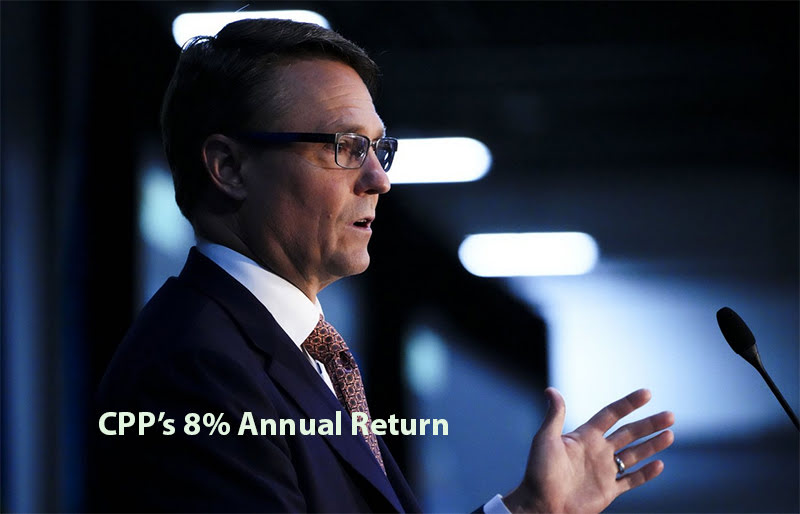The Canada Benefits Plan Investment Board (CPP), a foundation in dealing with the retirement assets of millions of Canadians, has denoted one more critical year of development and vital extension in its most recent monetary report finishing Walk 31. The Board detailed an eminent expansion in net resources, totalling CAD$632.3 billion, addressing a CAD$62 billion development over the earlier year. This growth demonstrates the fund’s robust health and highlights its crucial role in safeguarding the financial future of numerous Canadian retirees.
CPP’s 8% Annual Return
The Canada Benefits Plan Speculation Board (CPP), a foundation in dealing with the retirement assets of millions of Canadians, has denoted one more critical year of development and vital extension in its most recent monetary report finishing Walk 31. The Board detailed an eminent expansion in net resources, totalling CAD$632.3 billion, addressing a CAD$62 billion development over the earlier year. This growth demonstrates the fund’s robust health and highlights its crucial role in safeguarding the financial future of numerous Canadian retirees.
Also Check:-
CPP’s Fiscal Year Performance
Under the initiative of John Graham, president and Chief of CPP, the asset has kept on flourishing, utilizing a different venture portfolio and benefiting from worldwide market patterns. According to Global SWF’s rankings for the fiscal years 2014 through 2023, this strategic approach has resulted in substantial returns and placed the CPP among the top-performing public pension funds worldwide. This nitty gritty breakdown of the asset’s exhibition and a profound jump into its exchange features and key moves made all through the year give an extensive comprehension of the CPP’s tasks and its significant job in Canada’s monetary scene.
Analysis of Returns for the Canada Pension Plan
The Canada Benefits Plan Investment Board (CPP) revealed a thorough financial execution described by a broadened speculation technique that utilized different resource classes and geographic business sectors. The following is a brief breakdown of the vital measurements from the monetary report:
Overall Performance
- Net Assets: CAD$632.3 billion (up by CAD$62 billion from the previous year).
- Annual Net Return: 8%.
- 10-Year Annualized Return: 9.2%.
Performance by Asset Class
- Private Equity: 13.9% return, driven primarily by U.S. technology stocks.
- Public Equities: 8.4% return.
- Infrastructure: 5.9% return.
- Government Bonds: 0.3% return.
Geographic Contributions to Returns
- USA: 8.9%.
- Latin America: 7.7%.
- Canada: 4.2%.
Challenges
- Emerging Markets and Real Estate: Lower performance, dampening overall returns.
Additional CPP Account Performance
- Fiscal 2024 Return: 5.7%.
- Return Since Inception (2019): 5.6%.
Also Check:-
Notable Transactions
The board was active in private equity, investing a lot of money in things like:
- USD$50 million in Sands Capital Life Sciences Pulse III.
- CAD$250 million across two commitments with Toronto-based Northleaf Capital Partners.
Significant equity investments included:
- CAD$270 million in Inspira, a Brazilian K-12 education provider.
- CAD$534 million in KPN, a telecommunications company in the Netherlands.
CPP realized a partial interest in Viking Holdings and committed CAD$450 million to the UK-based aerospace parts and repair company Ontic following the fiscal year, with proceeds anticipated to total $714 million.
Criticism & Perspectives on Active Management
The active management strategy of the Canada Pension Plan Investment Board (CPP) has been the subject of scrutiny and criticism, particularly in light of the performance of the most recent fiscal year. Notwithstanding solid returns, inquiries regarding the viability of dynamic versus latent venture systems have arisen.
Criticism of Active Management
- CPP’s net return of 8%, according to critics like Globe & Mail columnist Andrew Coyne, pales in comparison to the potential returns from passive management strategies. For example, the asset’s benchmark ‘reference portfolio’ — a composite of worldwide value and bond files — procured a 19.9% annualized return.
- Coyne features that by chasing after dynamic administration, which includes choosing explicit stocks or resources, CPP passed up possibly multiplying its profits through detached procedures. “negative 0.1% annualized or negative $42.7 billion since the inception of active management in 2006,” he reports, is staggering.
Defence of Active Management
- Advocates of active management inside CPP contend that this approach takes into account better gamble the executives and variation to showcase changes, which are vital for the drawn out maintainability of benefits reserves.
- Dynamic administration likewise empowers CPP to make designated interests in areas and districts that may not be sufficiently covered by worldwide records, possibly prompting more significant yields in those areas.
Also Check:-
Bigg Boss OTT 3 Contestants List
The Debate
For large institutional investors like CPP, the debate between active and passive investment strategies is significant:
- The sheer scale of CPP’s ventures and their effect on Canadian retired people go with the decision of speculation methodology significant.
- In order to effectively maximize returns while effectively minimizing risks, CPP may need to periodically reevaluate its strategy to ensure that it is in line with global economic conditions and the changing financial markets.
The ongoing debate highlights a major pressure in speculation procedure for huge benefits reserves. Active management offers the flexibility to pursue specific opportunities and manage risks proactively, in contrast to passive strategies, which offer the allure of closely following market returns. The CPP’s strategy may need to be evaluated on a regular basis as the financial markets change in order to effectively balance strategic oversight with potential gains.
Final Words
In addition, criticisms of the fund’s management style sparked discussions during the fiscal year about whether active or passive investment strategies are more effective. These conversations are significant in molding future methodologies that might actually improve the asset’s proficiency and yield considerably more significant yields for its recipients. As we dig further into the CPP’s financial report, obviously the asset’s forward-looking administration and differentiated speculation approach are fundamental to its prosperity, setting a benchmark for public benefits reserves internationally.
